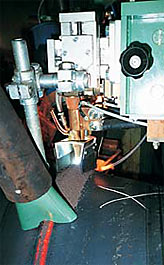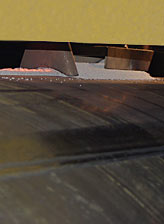

Submerged arc welding (SAW)
Large diameter pipes are welded in submerged arc welding (SAW) on the inside first and then on the outside (two-run welding).
SAW is an electric fusion welding process where the arc is submerged by a flux layer. Remarkable features of this welding process are a high deposition rate and a favourable heat balance.
Deposition rate and heat balance directly depend on the current used and thus also depend on the number of electrodes used.
Uhrhan & Schwill specialised in multiple-arc welding and for longitudinal seam pipe production produces internal SAW systems with up to four electrodes and external SAW systems with up to five electrodes.
For spiral pipe production, up to three electrodes are used for internal and external SAW.
By employment of multiple-are technology, the deposition rate is increased. This increased deposition rate results in higher welding speeds.
During welding, the arcs melt off the strip edges and the welding consumables and a liquid weld pool is formed. In combination with the accumulated flux, this weld pool protects the arcs against external influences and cools down after the arcs have passed. The seam has now been produced.
Since in the weld pool a compound of base metal and welding consumables is generated, the chemical and physical composition of the welding consumables is of decisive importance for the seam quality.
During welding, the electrode is completely melted off, while the flux is not entirely consumed. The upper flux layer, which is not entirely melted off, hardens to form a slag layer on the seam. After cooling down, the slag can be removed in a separate production step.
On the slag layer, there is the flux that has not melted. When using a high-quality flux feeding and suction system, the rest of the flux can be reused in the following welding processes.
For multiple-arc technology, apart from using adequate welding consumables, the possibility to set optimum process parameters is a prerequisite to comply with the required quality demands.
Here you find an overview of welding speeds.









